Elevate Your Home: 22 Creative Accent Ceiling Ideas for Stunning Interior Design
While walls and floors often steal the spotlight in home decor, the ceiling offers an incredible, yet frequently overlooked, canvas for creativity. An accent ceiling is a powerful design element that can dramatically enhance a room’s style, add personality, and even influence its perceived size and mood. Far from being just a plain white surface, your ceiling holds immense potential to become a striking feature.
From vibrant paint colors and intricate wallpapers to the warmth of wood panels and elegant beams, there are countless ways to create an accent ceiling. Whether your taste leans towards something bold and dramatic or subtle and sophisticated, there’s an idea to fit every aesthetic and budget. This comprehensive guide explores diverse accent ceiling ideas designed to inspire and help you transform your living spaces.
Ready to infuse your home with unique color, captivating texture, or a distinctive pattern? Let’s discover how to give your ceilings a stylish upgrade and make every room feel more complete and thoughtfully designed.
What Is an Accent Ceiling and Why It’s a Game-Changer for Your Home
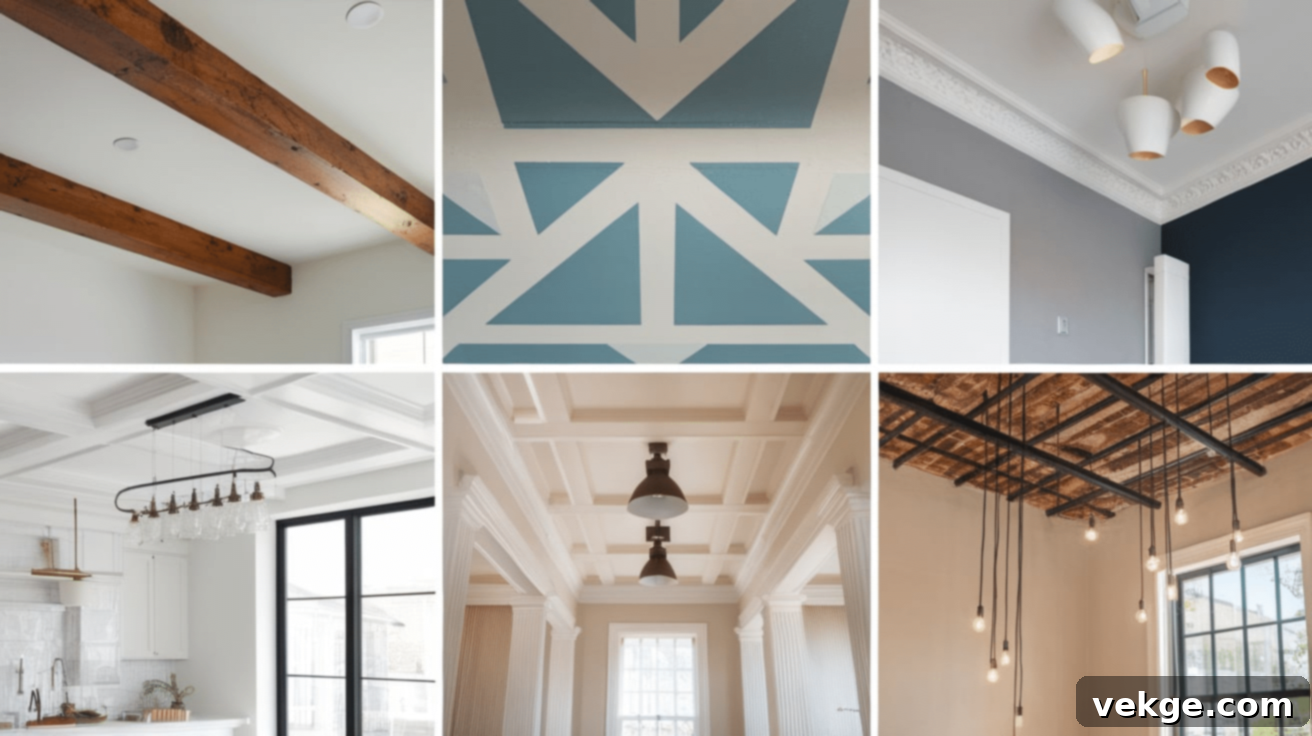
Simply put, an accent ceiling is a ceiling that purposefully stands out from the rest of the room. Instead of the standard plain white finish, it incorporates color, texture, or a unique design to become a focal point. Much like an accent wall draws the eye and injects character, an accent ceiling directs attention upwards, transforming an ordinary space into something truly special.
A thoughtfully designed accent ceiling does more than just look good; it can significantly alter the ambiance of a room. It can make a compact space feel more expansive, add a sense of cozy intimacy to a larger area, or elevate a simple room to a new level of sophistication. The beauty lies in its versatility—you can paint it a striking color, install elegant wood beams for warmth, apply patterned wallpaper for visual interest, or integrate architectural details that command attention.
Adding an accent ceiling is an ingenious way to infuse your home with a distinct personality without undertaking a full renovation. Here are several compelling reasons why an accent ceiling is a worthwhile addition to almost any home:
1. Instantly Enhances Visual Interest: A decorated ceiling lifts the eye, adding an unexpected layer of design to a room. It breaks the monotony of a plain ceiling, introducing character and making the space feel more dynamic and stylish.
2. Adds Depth and Dimension: Depending on the chosen design, an accent ceiling can dramatically influence the perception of space. Darker colors or intricate patterns can create a sense of intimacy and coziness, while lighter hues or reflective finishes can make a room feel taller and more open. This architectural element changes how a space feels without consuming any precious floor space.
3. Works in Any Room and Style: From the serenity of a bedroom to the vibrancy of a living room, the practicality of a kitchen, or the calm of a bathroom, an accent ceiling is adaptable to virtually any environment. You have the freedom to choose between a bold, statement-making design or a subtle, understated touch, ensuring there’s an ideal option for every personal style and existing decor theme.
Ultimately, an accent ceiling is an accessible yet impactful way to upgrade your home, ensuring your spaces feel finished, refined, and distinctly yours!
22 Creative Accent Ceiling Ideas to Inspire Your Home Transformation
Ready to move beyond the ordinary? An accent ceiling is a fantastic opportunity to inject style and personality into any room. Instead of leaving your ceiling plain and forgotten, explore these creative ideas to make it a standout feature that elevates your entire home.
1. Bold Painted Ceiling
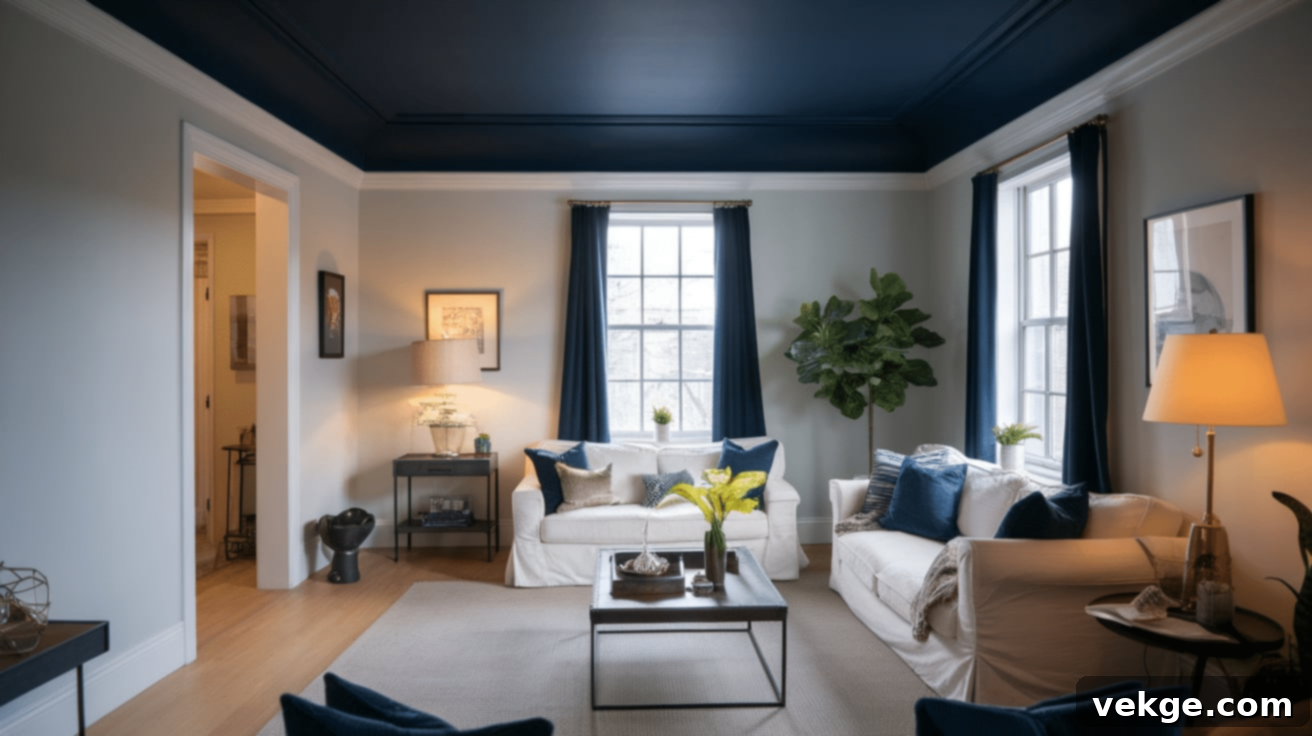
Painting your ceiling a bold, unexpected color can completely redefine the mood of a room. Darker shades like navy blue, deep charcoal, or rich forest green create a sense of intimacy and coziness, perfect for a bedroom or a sophisticated dining room. Conversely, bright colors such as sunny yellow or vibrant coral can infuse a space with energy and playfulness, making them ideal for a child’s room or a creative studio. A bold ceiling is also an excellent way to introduce striking contrast if your walls are painted in neutral tones, adding a dramatic focal point without overwhelming the decor.
2. Soft Pastel Ceiling

For those who prefer a more gentle touch of color, a pastel ceiling is a perfect choice. Soft blues, mint greens, blush pinks, or lavender can imbue a room with a serene, calming, and inviting atmosphere. This approach adds subtle visual interest without overpowering the existing decor. Pastel ceilings are particularly effective in bedrooms, nurseries, or tranquil reading nooks where a peaceful and restful ambiance is desired, creating a subtle canopy that soothes the senses.
3. Two-Tone Ceiling
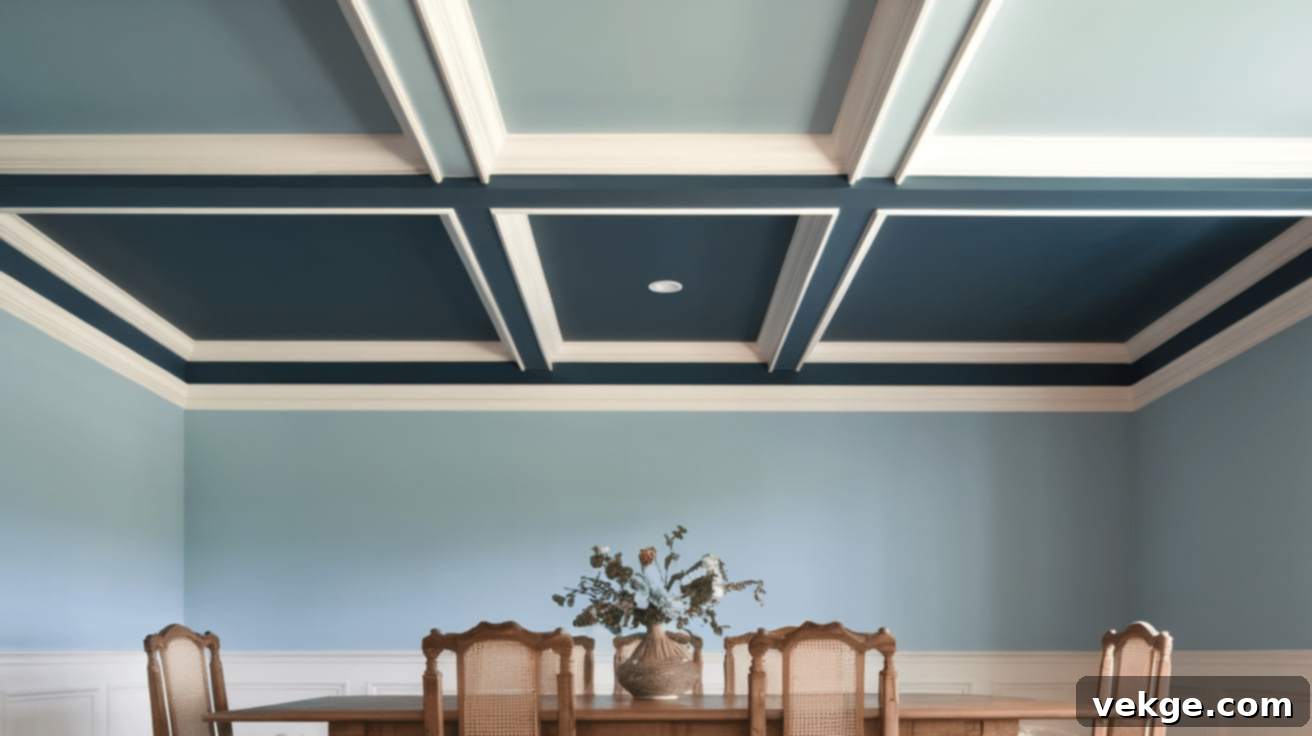
Why limit yourself to one color when you can use two? A two-tone ceiling can create a sophisticated, framed appearance, especially effective in rooms with crown molding or tray ceilings. You might paint the main ceiling surface one color and the perimeter or recessed area a contrasting or complementary shade. This technique instantly adds architectural depth and visual intrigue. Choosing contrasting colors can make a bold statement, while using similar shades offers a more refined and subtle dimensional effect, perfect for living rooms or dining areas.
4. Striped Ceiling

Stripes aren’t just for walls and floors; they can make an equally stunning statement on the ceiling. A striped ceiling introduces dynamic movement and can cleverly manipulate the perception of a room’s height or width. Horizontal stripes can make a narrow room feel broader, while vertical stripes draw the eye upward, creating the illusion of a taller space. Use neutral tones for a chic and understated effect, or opt for bright, contrasting colors for a fun, playful look. This idea is particularly popular for kids’ rooms, playrooms, or creative studio spaces where whimsy is welcome.
5. Stenciled Ceiling

For intricate and elaborate designs without the need for advanced freehand painting skills, stencils are your best friend. A stenciled ceiling allows you to apply beautiful patterns, from delicate floral motifs and classic geometric shapes to custom designs that mimic the look of expensive wallpaper or antique tin tiles. This technique offers a cost-effective way to achieve an elegant and bespoke look, adding a touch of personalized artistry and sophistication to any room, particularly effective in dining rooms, entryways, or even powder rooms.
6. Glossy Ceiling
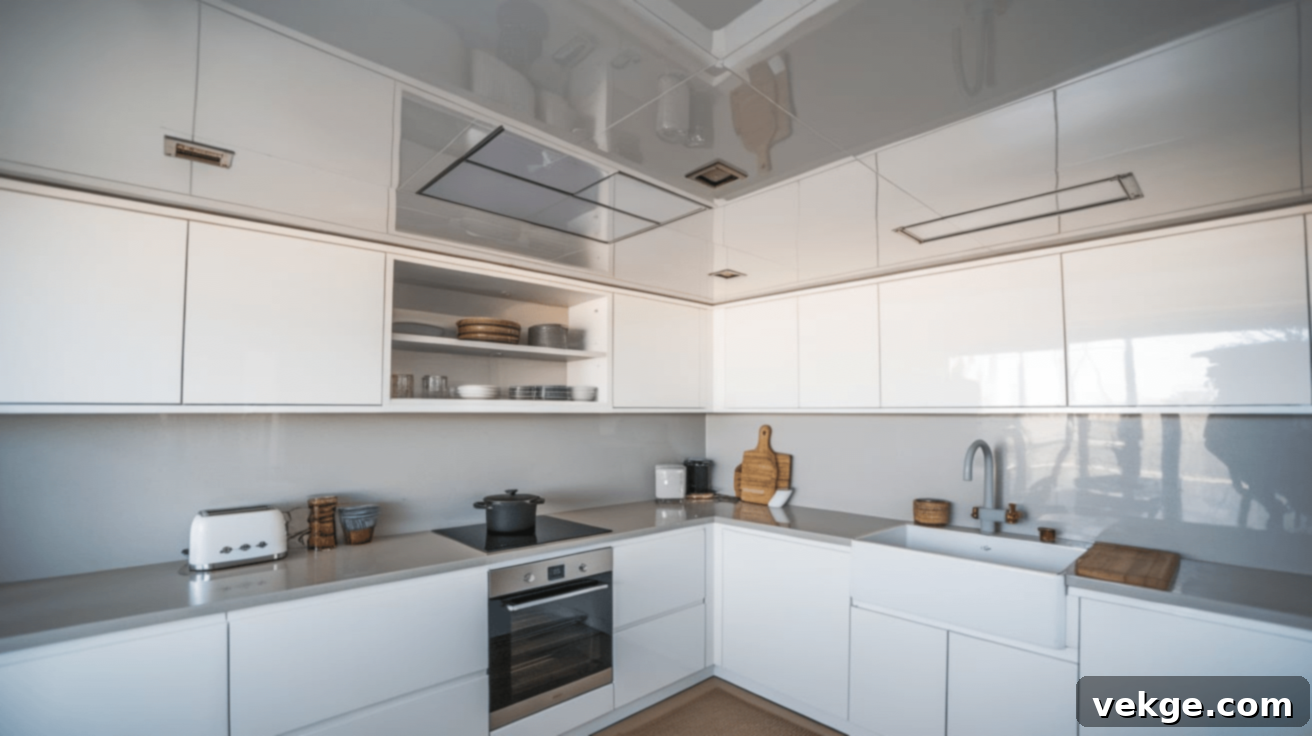
A high-gloss finish on your ceiling can dramatically elevate a space, imparting a sleek, modern, and luxurious feel. Beyond its aesthetic appeal, a glossy surface acts as a mirror, reflecting light—both natural and artificial—which can make a room feel significantly larger, brighter, and more open. This effect is especially powerful in rooms with ample natural light, creating a dazzling and dynamic overhead vista. For best results, ensure your ceiling is perfectly smooth before applying a high-gloss paint, as any imperfections will be highlighted by the reflective finish.
7. Matte Black Ceiling

Dare to go dark? A matte black ceiling is a bold, dramatic, and surprisingly chic choice. While it might seem counterintuitive, a dark ceiling can make a large, expansive room feel much cozier and more intimate, creating a warm, enveloping effect. It also serves as an exceptional backdrop for highlighting stunning lighting fixtures, making chandeliers or pendant lights pop with sophisticated contrast. This look works beautifully in contemporary living rooms, minimalist bedrooms, or even modern kitchens when paired with lighter-colored walls and metallic accents to balance the visual weight.
8. Wallpapered Ceiling

Break free from the idea that wallpaper is only for walls! A patterned wallpaper ceiling is an extraordinary way to add unparalleled depth, texture, and visual storytelling to a room. From intricate florals and bold geometrics to faux textures like wood grain or brick, the possibilities are endless. Wallpaper can transform a plain ceiling into a captivating design statement. This approach is particularly effective in bedrooms, dining rooms, or even powder rooms where you want to create a truly memorable and immersive design experience. Peel-and-stick options also make this a feasible DIY project.
9. Wood Plank Ceiling
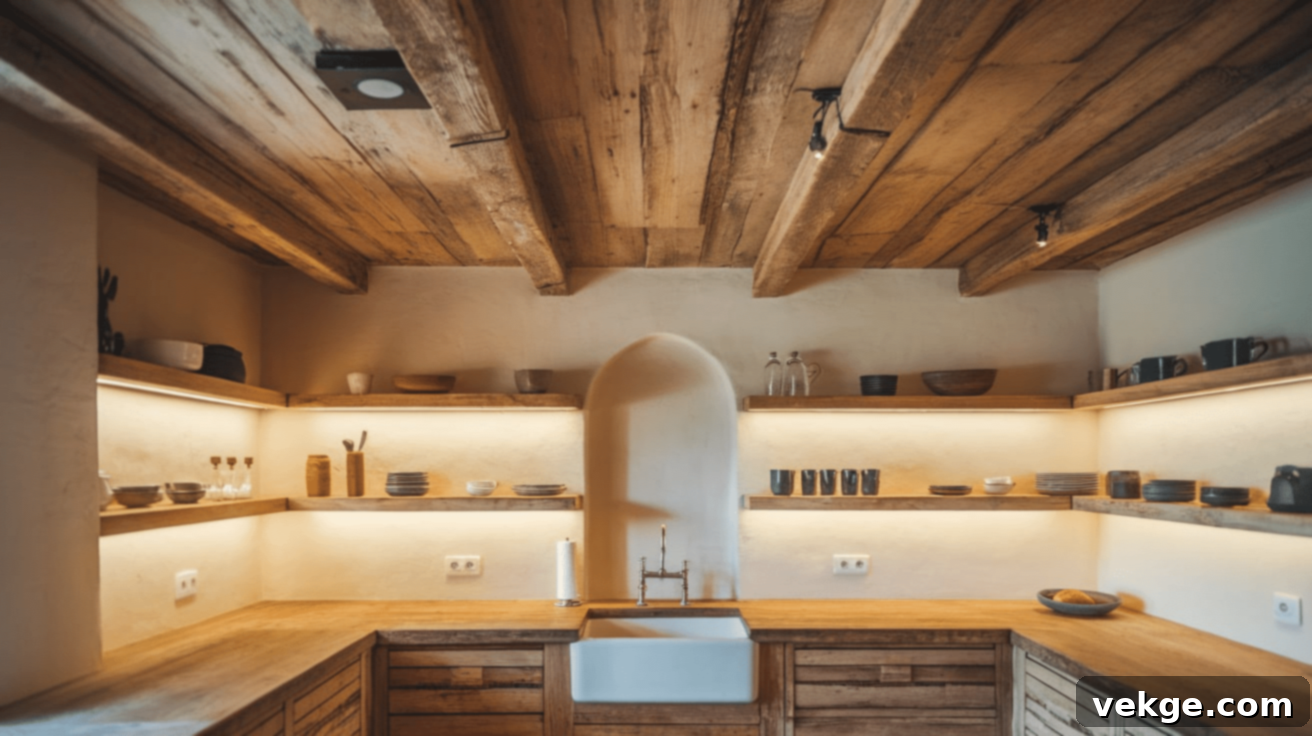
Infuse your home with natural warmth and texture by installing a wood plank ceiling. Whether you opt for rustic reclaimed wood to evoke a farmhouse charm or smooth, lacquered planks for a modern, Scandinavian aesthetic, wood adds undeniable character and coziness. The grain and tone of the wood naturally draw the eye, creating a comforting and grounded atmosphere. Wood ceilings are incredibly versatile and can enhance the appeal of kitchens, living rooms, and even bathrooms, bringing an element of nature indoors.
10. Shiplap Ceiling
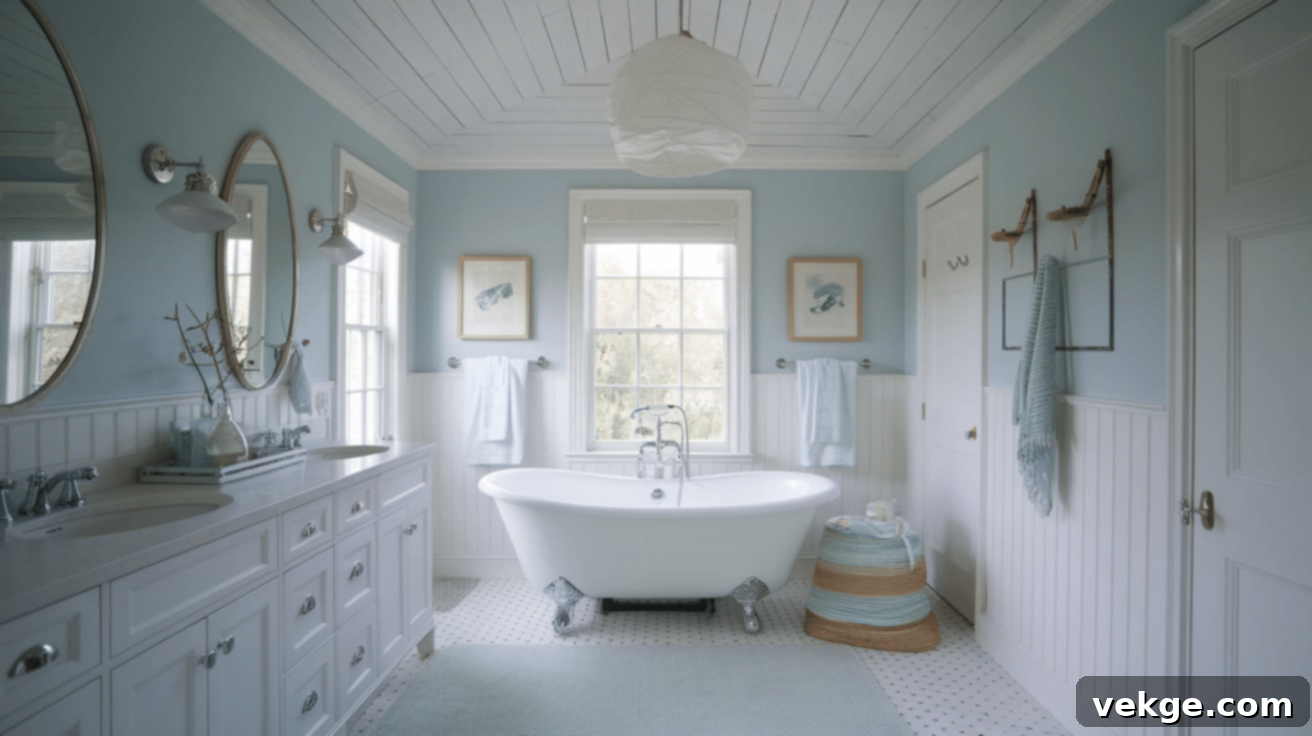
Shiplap, a classic wood paneling style characterized by overlapping boards, brings a charming farmhouse or coastal cottage touch to any space. White-painted shiplap offers a clean, crisp, and timeless look that brightens a room, while natural wood tones add rustic warmth and texture. You can install shiplap in a traditional straight pattern or a more dynamic diagonal orientation for a unique visual effect. It’s an ideal choice for kitchens, bathrooms, laundry rooms, or any space where you want to evoke a relaxed, inviting, and slightly vintage feel.
11. Exposed Beam Ceiling

Exposed wooden beams are a quintessential feature for creating a rustic, inviting, and architecturally rich atmosphere. Even if your home doesn’t boast genuine structural beams, you can achieve the same grand effect with faux beams, which are often lighter and easier to install. These robust elements add dramatic visual lines and a sense of history to a room. They work exceptionally well in living rooms, dining areas, and particularly stunning with vaulted or cathedral ceilings, where they emphasize height and grandeur. Staining or painting the beams allows for customization to perfectly match your decor, whether you’re aiming for a farmhouse, industrial, or modern look.
12. Coffered Ceiling
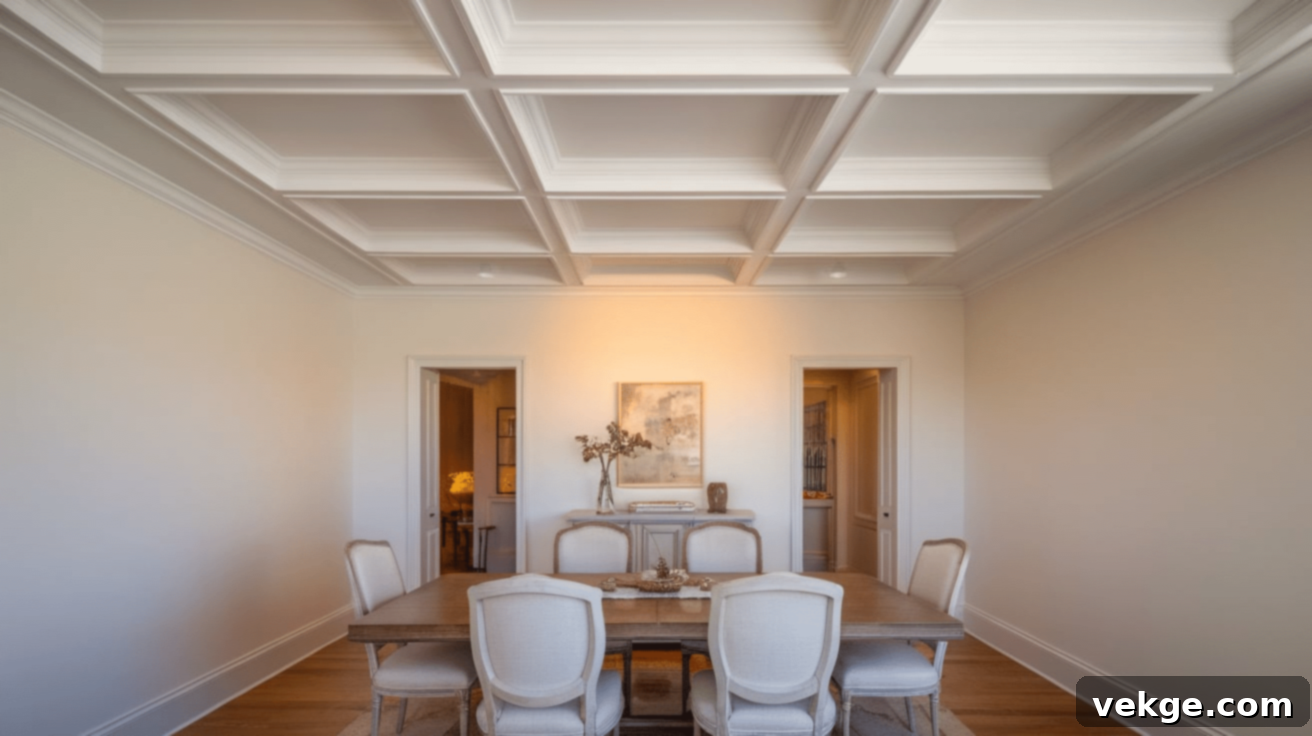
A coffered ceiling is the epitome of classic elegance and sophisticated architectural detail. Featuring a grid of recessed panels, typically framed with decorative molding, this design adds significant depth and grandeur to a space. Coffered ceilings are best suited for formal living rooms, dining areas, libraries, or studies where a traditional, luxurious, and stately aesthetic is desired. Painting the recessed panels a different color from the beams creates striking contrast, while adding subtle lighting within the recesses can further highlight this exquisite architectural feature and enhance the room’s ambiance.
13. Tray Ceiling with Lighting
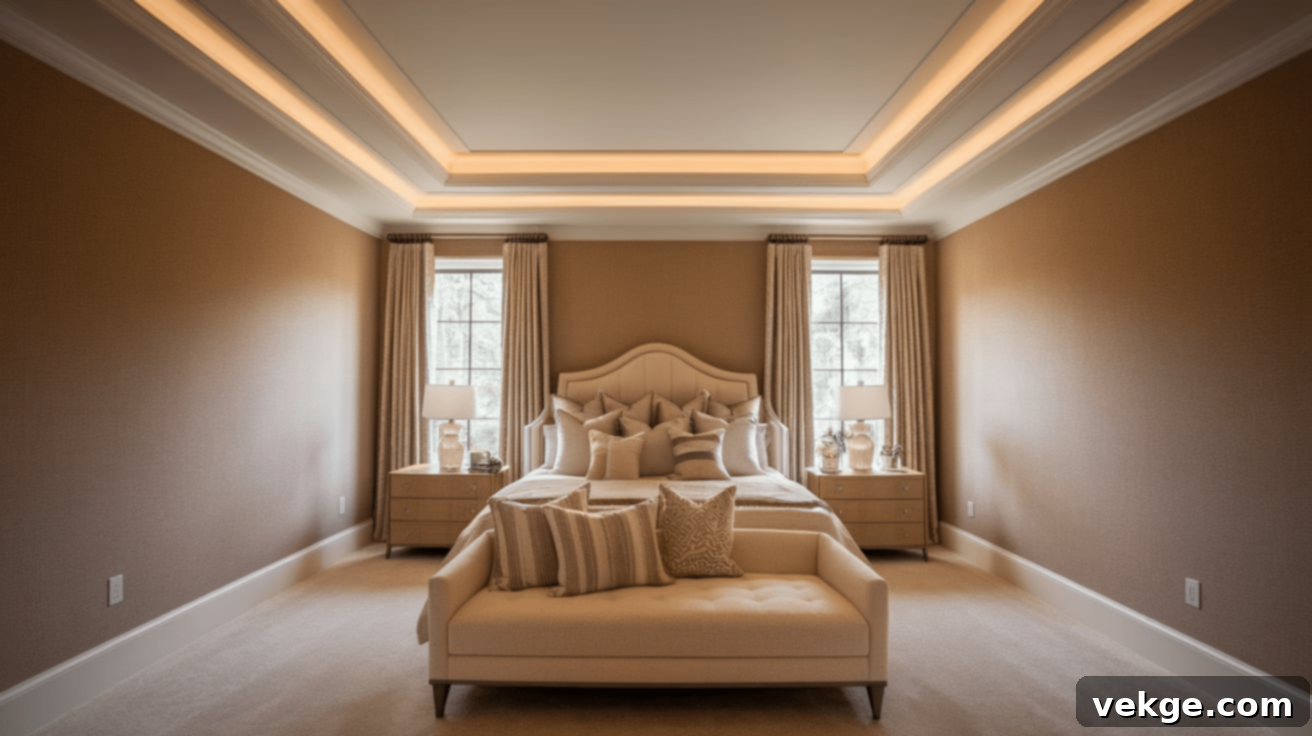
A tray ceiling, characterized by a recessed center area, inherently adds depth and a custom feel to a room. When combined with hidden LED strip lighting installed within the perimeter of the tray, it transforms into an incredibly special and atmospheric feature. This design creates a soft, ambient glow that makes a room feel more luxurious and inviting, especially during the evening. It’s a fantastic option for bedrooms, living rooms, and master suites where you want to create a focal point that is both stylish and functional. Enhancing the look with a contrasting paint color in the recessed area or elegant crown molding can further elevate its sophisticated appeal.
14. Tin Tile Ceiling
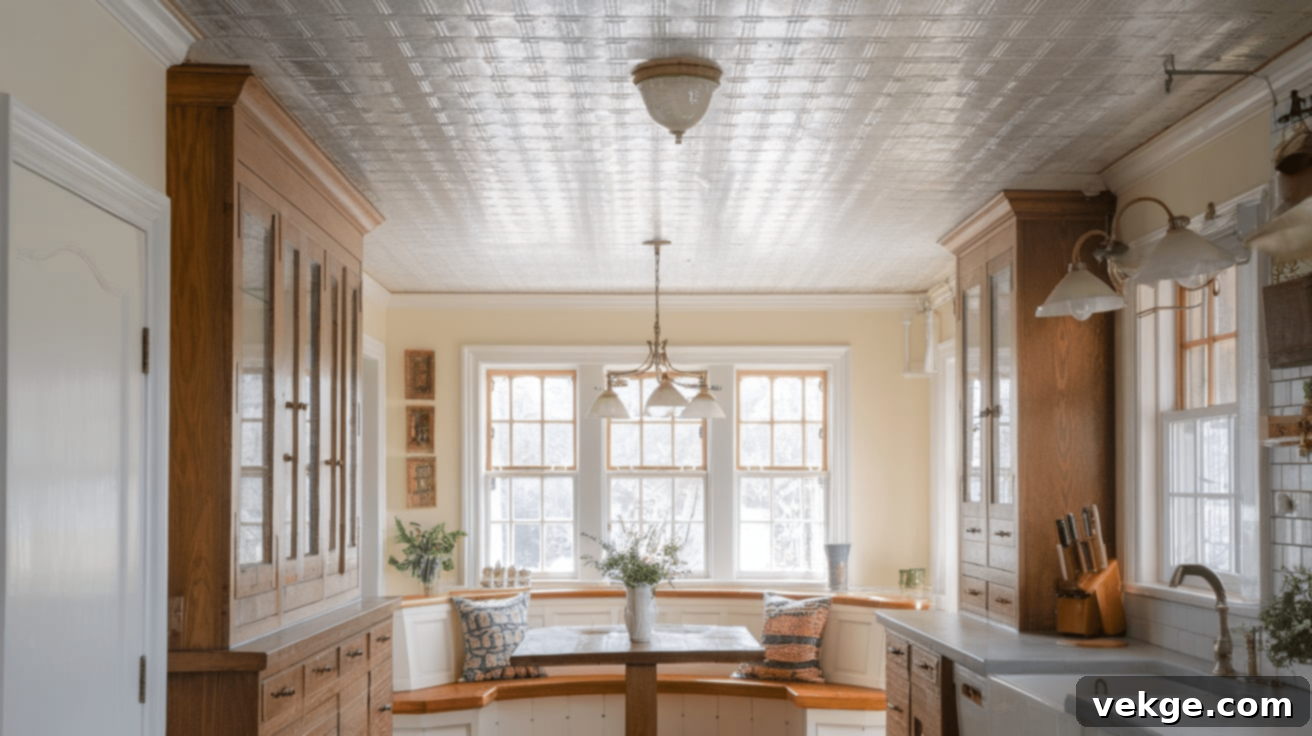
For a touch of vintage charm and historical elegance, consider a tin tile ceiling. These decorative metal tiles, often featuring intricate embossed patterns, add unique texture and a classic antique feel to any space. Available in various finishes, including polished metallic or painted, they can be customized to match your decor, whether you’re aiming for an authentic Victorian look or a shabby-chic vibe. Tin tiles are particularly well-suited for kitchens, bathrooms, home offices, or eclectic dining areas. Their subtly reflective surface also helps to brighten a room, making them both beautiful and practical.
15. Faux Brick Ceiling

Bring an urban industrial edge or a rustic, loft-style aesthetic to your home with a faux brick ceiling. This distinctive design can be achieved using lightweight brick panels or even specialized wallpaper that realistically mimics the texture and appearance of real brick. It’s an excellent choice for modern loft apartments, basements, or any space where you want to add an edgy, raw, or repurposed feel. Pair it with exposed pipes, metal fixtures, or minimalist decor for an authentic urban look, or opt for whitewashed brick for a softer, more contemporary farmhouse touch.
16. Sky Mural Ceiling
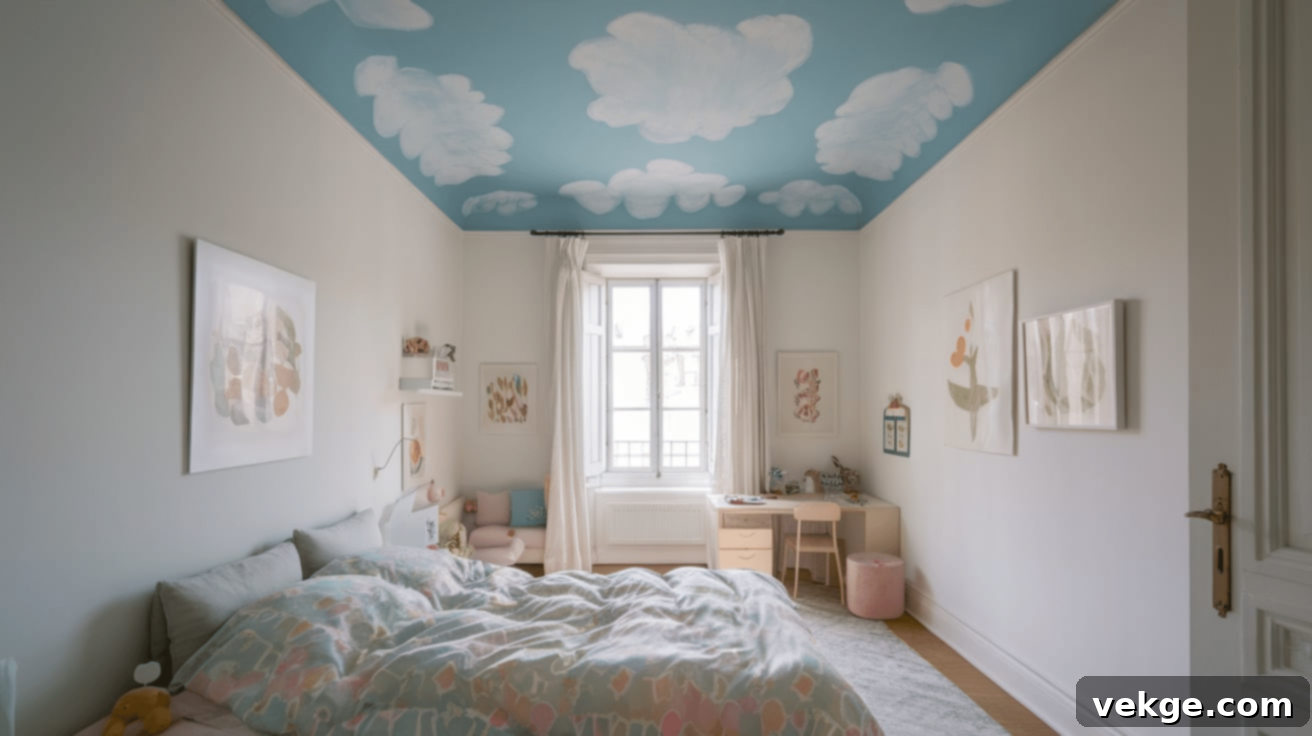
Transform your ceiling into an expansive, tranquil sky with a beautiful mural. Soft blues interspersed with wispy white clouds can create a wonderfully peaceful and dreamy atmosphere, perfect for bedrooms, nurseries, or relaxation spaces. For an extra magical touch, consider adding glow-in-the-dark stars to simulate a stunning night sky. Beyond traditional clouds, you could explore a serene sunset gradient, a celestial galaxy theme with deep purples and shimmering accents, or even a whimsical constellation map. This idea truly elevates the ceiling to a piece of immersive art.
17. Geometric Pattern Ceiling

For a contemporary and stylish ceiling statement, geometric patterns offer endless possibilities. Whether you paint bold triangles, intricate hexagons, dynamic chevrons, or abstract interlocking shapes, these designs can make a ceiling a captivating focal point. This modern aesthetic is particularly well-suited for home offices, creative studios, kids’ playrooms, or entryways where you want to make a strong visual impact. Using contrasting colors will make the patterns pop with high energy, while subtle tonal variations can create a more sophisticated and understated yet equally striking effect. Stencils can be invaluable tools for achieving crisp, precise designs.
18. Bamboo Ceiling
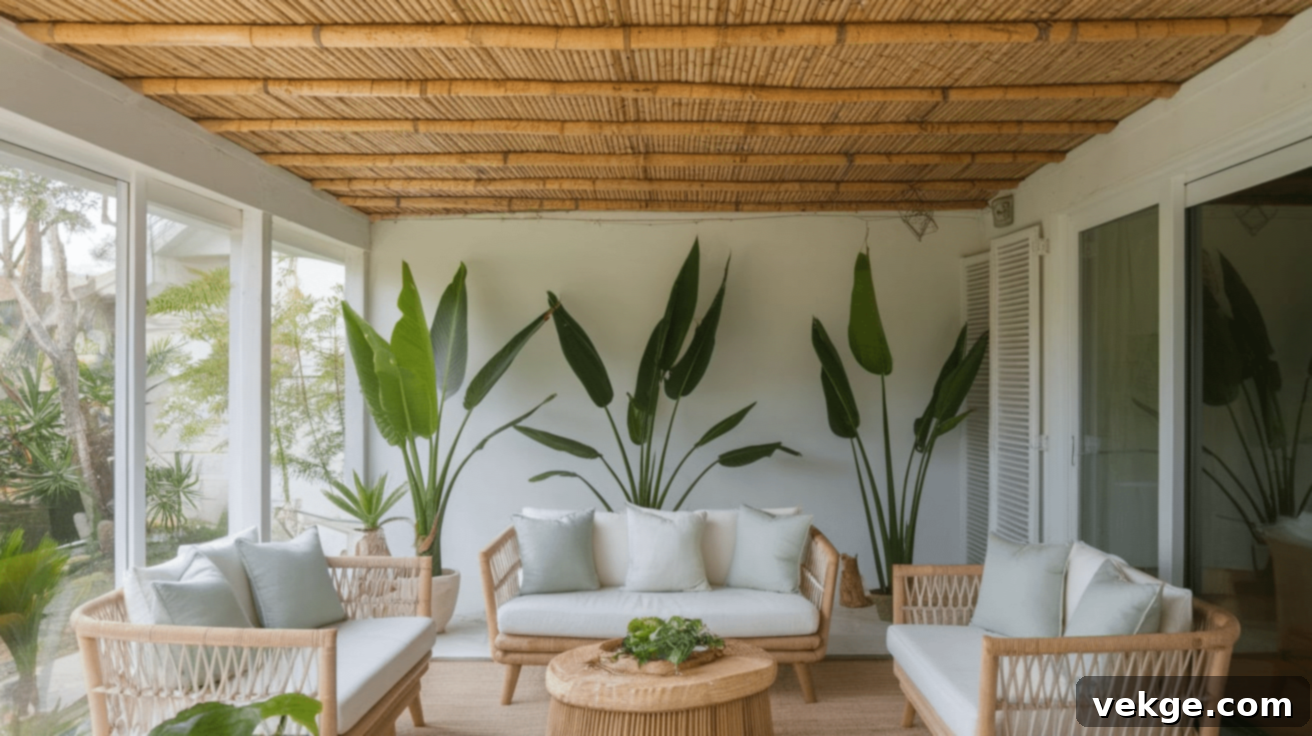
Instantly evoke a tropical, relaxed, and exotic ambiance with a bamboo ceiling. This natural material brings an organic texture and a unique, vacation-like feel to any space. Ideal for sunrooms, enclosed patios, beach-themed homes, or spa-inspired bathrooms, a bamboo ceiling creates a sense of tranquility and connection to nature. You can utilize real bamboo panels for an authentic touch or opt for bamboo-printed wallpaper for a similar visual effect that’s easier to install. Pairing it with rattan furniture, lush tropical plants, and warm, diffused lighting will enhance the breezy, natural charm of the room.
19. Concrete-Style Ceiling
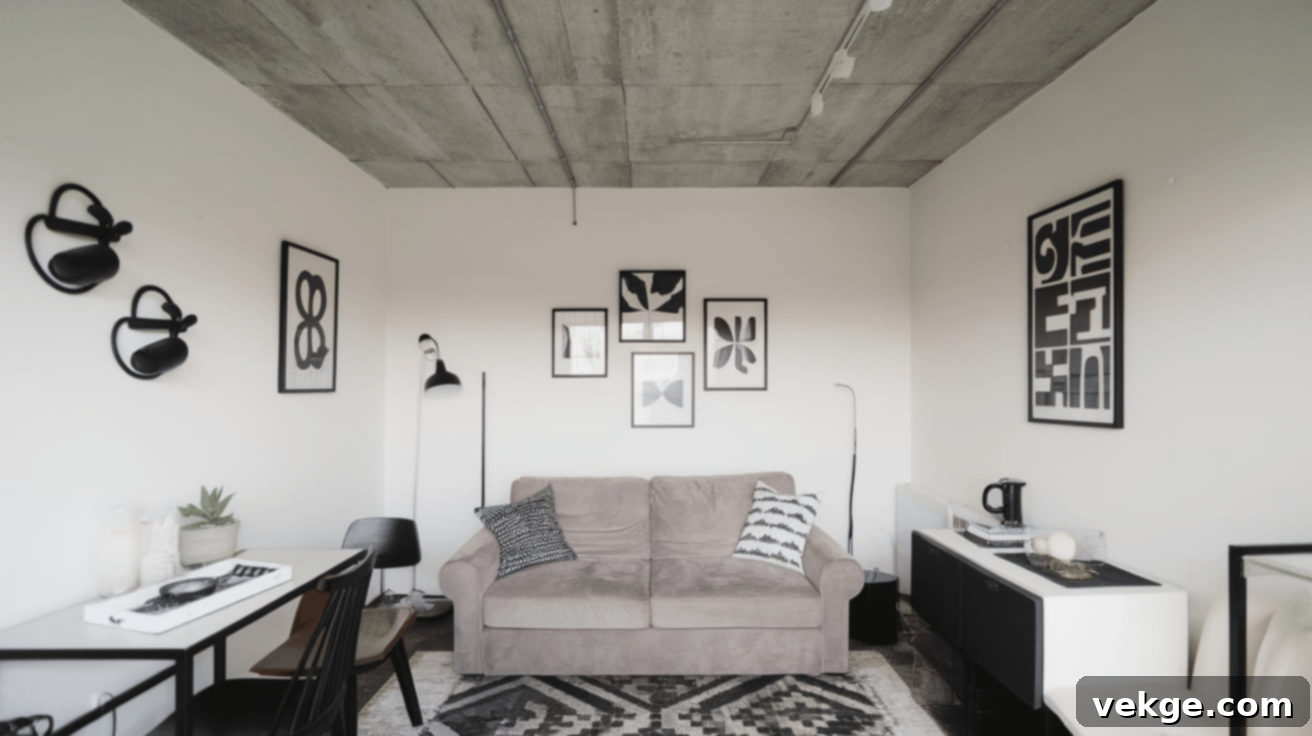
Embrace a raw, industrial, and decidedly modern aesthetic with a faux concrete-style ceiling. This look is perfect for achieving a minimalist, urban, or loft-inspired interior. You can replicate the textured appearance of concrete through specialized paint techniques, plaster applications, or even high-quality wallpaper designed to mimic its unique finish. This design works exceptionally well in lofts, modern offices, contemporary living spaces, or even industrial-chic kitchens. To enhance the urban vibe, pair it with exposed ductwork, metal fixtures, or introduce warm wood accents to prevent the space from feeling too cold or stark.
20. Herringbone Wood Ceiling

The timeless elegance of the herringbone pattern isn’t just for floors; it creates a stunning and sophisticated accent on a ceiling. A wood ceiling arranged in this distinctive zig-zag style adds incredible visual texture, architectural interest, and a sense of refined craftsmanship. This design is particularly impactful in dining rooms, elegant bedrooms, or grand entryways where you want to make a luxurious statement. Whether you choose deeply stained wood for a warm, traditional feel or opt for painted wood in lighter tones for a more contemporary and airy look, a herringbone ceiling is guaranteed to impress.
21. Color-Blocked Ceiling
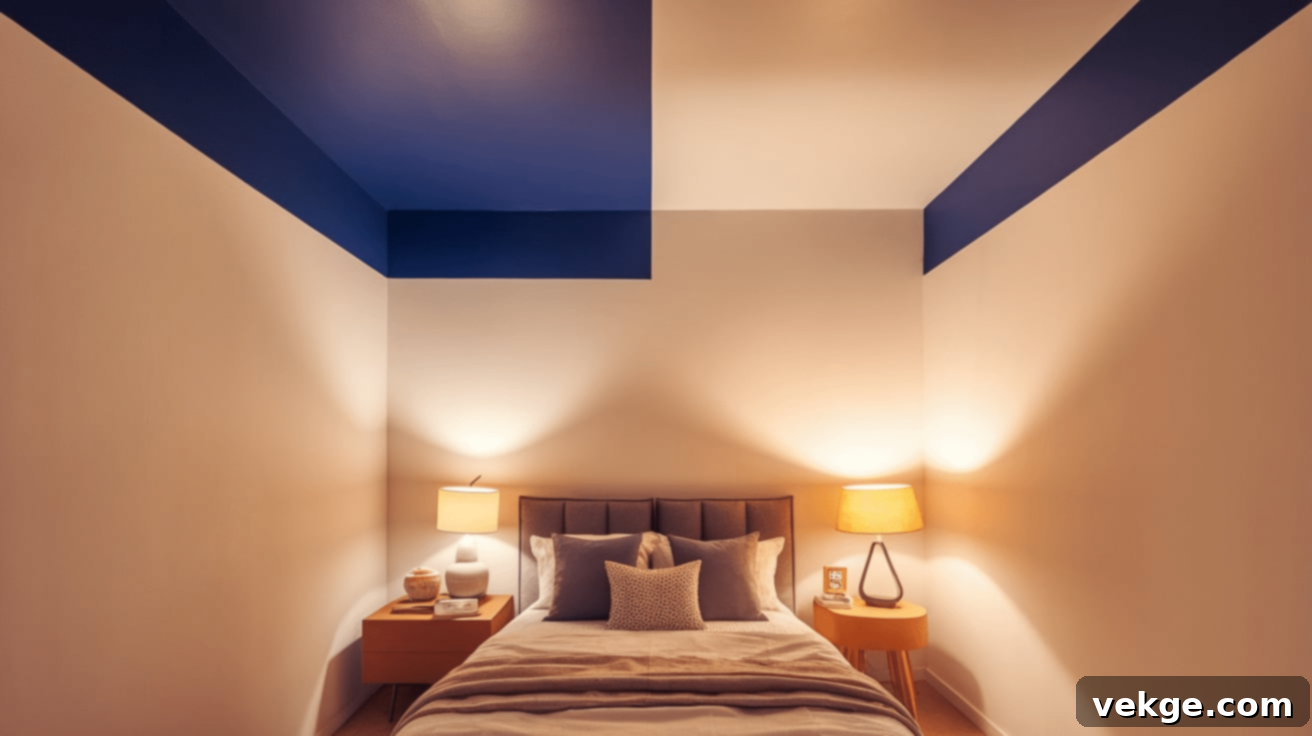
Move beyond a single solid color by experimenting with color-blocking on your ceiling. This contemporary design technique involves using two or more distinct colors to create bold, graphic divisions or geometric shapes. You might paint half of the ceiling one color and the other half a contrasting shade for a striking, modern division, or incorporate dynamic diagonal lines, squares, or abstract shapes. Color-blocking is an excellent way to inject a playful yet sophisticated energy into a space, adding unique visual interest and a highly personalized touch. It works particularly well in creative spaces, children’s rooms, or modern living areas.
22. Vintage Pressed Ceiling
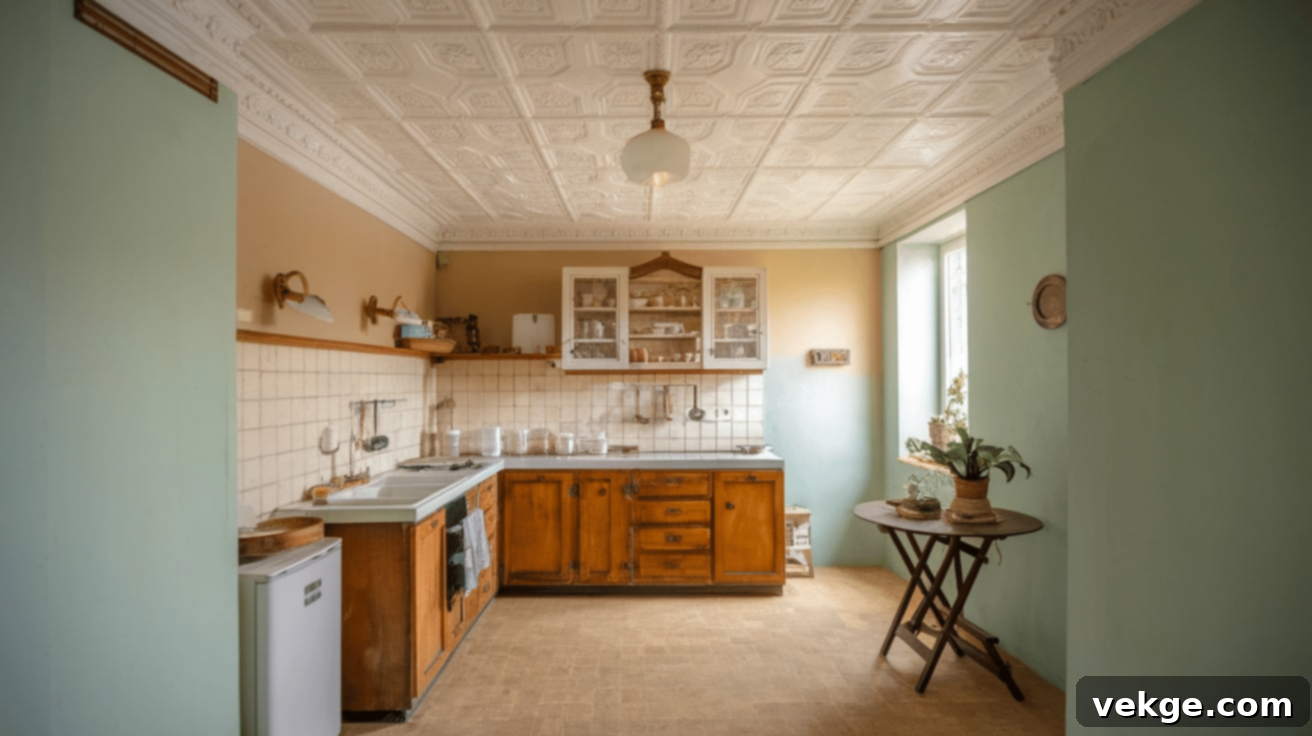
For rooms that crave an old-world charm and intricate detailing, a vintage pressed ceiling is a beautiful choice. Inspired by traditional pressed tin ceilings, this look can be achieved with faux tin panels, embossed wallpaper, or specialized plasterwork that replicates ornate historical patterns. It lends a distinct antique aesthetic and a sense of grandeur, making it ideal for historic homes, Victorian-inspired interiors, or spaces with a classic, vintage decor theme. Choosing metallic finishes like aged bronze or silver can enhance the authentic antique look, while painted panels offer a softer, perhaps more modern, interpretation of this classic design element.
As you can see, incorporating an accent ceiling is a brilliant way to give your space a unique and stylish edge. Whether you opt for a simple coat of bold paint or a complex, detailed design, your ceiling has the potential to become one of the most eye-catching and memorable features of your home!
How to Choose the Right Accent Ceiling for Your Home
Deciding to add an accent ceiling is an exciting step, but with so many captivating options, selecting the perfect one can feel overwhelming. The key is to consider what truly complements your existing space and personal style. Here are some essential tips to guide you through the decision-making process, ensuring your chosen accent ceiling perfectly enhances your home.
1. Evaluate Your Room’s Existing Style and Decor
Your accent ceiling should seamlessly integrate with the overall aesthetic of the room. If your home embraces a sleek, modern design, then a glossy finish, a geometric pattern, or a concrete-style ceiling might be the perfect fit. For a cozy farmhouse vibe, consider warm wood beams, classic shiplap, or rustic tin tiles. A home with traditional or classic decor would be beautifully complemented by the elegance of coffered ceilings or a sophisticated tray ceiling. Always choose a design that feels cohesive with your furniture, wall colors, and general decorative theme.
2. Consider Your Ceiling Height
The height of your ceiling is a crucial factor in determining the most effective accent style. For rooms with lower ceilings, avoid dark colors or overly busy patterns, as these can make the space feel even smaller and more confined. Instead, opt for lighter colors, reflective glossy finishes, or subtle textures like a delicate wallpaper pattern to create an illusion of openness and height. Conversely, if you’re blessed with high ceilings, you have more freedom. This is where bold colors, dramatic exposed beams, deep coffered designs, or substantial wood paneling can make the space feel cozier, more grounded, and beautifully balanced without feeling overwhelming.
3. Select the Right Color Palette
Color profoundly impacts the mood and perceived size of a room. Light colors, such as crisp whites, soft beiges, pale greys, or gentle pastels, are excellent for making a space feel larger, brighter, and more airy. They reflect light and open up the room. On the other hand, dark colors—like deep navy, charcoal grey, rich forest green, or matte black—create a sense of intimacy, drama, and coziness, ideal for a more luxurious or enveloping atmosphere. If you’re aiming for a bold statement, choose a vibrant or rich color that provides a striking contrast to your walls, adding personality and flair.
4. Pick a Finish That Works with Your Vision
The finish of your ceiling plays a significant role in its overall impact. A matte finish offers a soft, contemporary, and non-reflective look that absorbs light, creating a sophisticated backdrop. A high-gloss or metallic finish, however, is highly reflective, bouncing light around the room and making the space feel more expansive and luxurious. If adding textural depth is your goal, consider materials like wood paneling, shiplap, or patterned wallpaper, which introduce tactile interest and a three-dimensional quality to the ceiling surface.
5. Integrate with Existing or Planned Lighting
Lighting can completely transform how your accent ceiling appears throughout the day and night. A darker accent ceiling can create a beautiful, rich contrast when illuminated by ample natural light. In rooms with less natural light, a lighter-colored or reflective ceiling can help maximize the available illumination and brighten the space. Additionally, consider how built-in lighting features—such as recessed lights, hidden LED strips in tray ceilings, or striking pendant fixtures—will interact with and enhance your chosen ceiling design. Lighting isn’t just functional; it’s an integral part of your ceiling’s aesthetic.
Choosing the right accent ceiling is ultimately about finding a harmonious balance between style, function, and your unique personal taste. Take your time, carefully assess your space, and select a design that resonates with your home’s character and your lifestyle. With the right choice, your ceiling will cease to be merely a structural element and will instead become one of the most captivating and talked-about features in your home!
DIY vs. Hiring a Professional for Your Accent Ceiling
Once you’ve settled on the perfect accent ceiling idea, the next big decision is whether to tackle the project yourself or enlist the help of a professional. Both routes have distinct advantages and disadvantages, largely depending on your skillset, budget, the complexity of the design, and the time you have available. Understanding these factors will help you make the best choice for your home renovation.
When to Embrace DIY
If your chosen accent ceiling involves simpler tasks like painting, applying wallpaper (especially peel-and-stick varieties), or installing basic lightweight panels, a DIY approach can be an incredibly rewarding and cost-effective option. These types of projects generally don’t require specialized tools or extensive construction knowledge, mostly demanding patience, attention to detail, and a steady hand. If you enjoy home improvement projects, have a knack for creative tasks, and possess the spare time, going the DIY route can not only save you money on labor costs but also provide immense personal satisfaction from transforming your space with your own hands. It’s a great way to update your home on a tighter budget.
When to Hire a Professional
For more complex and intricate ceiling designs, such as installing coffered ceilings, structural or faux wood beams, elaborate molding, or working with specialized materials like tin tiles that require precise cuts and adhesion, hiring a professional is often the wiser choice. These projects frequently demand advanced carpentry skills, specialized equipment, knowledge of structural considerations, and experience with intricate finishes. A skilled professional can ensure the installation is done correctly, safely, and efficiently, adhering to high-quality standards that might be challenging for a novice. While professional services come at a higher cost, they often save you time, stress, and potential costly mistakes, delivering a polished and durable result.
Cost Considerations
The financial aspect is often a primary driver in this decision. DIY projects are inherently more budget-friendly as your main expenditures will be for materials, paint, wallpaper, or panels. Professional installation, however, includes labor costs, which can significantly increase the total project price. When weighing the costs, consider the value of your time, the potential for error in a DIY project (which could lead to additional expenses for rectifying mistakes), and the assurance of a high-quality finish from an experienced professional. If your budget is tight, starting with a simpler DIY accent ceiling is a smart way to get an immediate impact, reserving larger, more complex projects for when you can invest in professional expertise.
Ultimately, the decision to DIY or hire a pro boils down to the complexity of your chosen design and your comfort level with the required tasks. For simple cosmetic upgrades, DIY is a fantastic option. For structural changes, intricate installations, or if you prefer a flawless, professional finish without the stress, bringing in an expert is highly recommended. Choose the path that best aligns with your skills, budget, and vision for your home.
Conclusion: Unlock Your Ceiling’s Potential
An accent ceiling is a surprisingly impactful design element, offering a unique opportunity to infuse your home with unparalleled style and personality. Whether you envision a bold splash of paint, a captivating patterned wallpaper, the organic warmth of wood panels, or the architectural grandeur of a coffered design, the right ceiling treatment can fundamentally transform the feel and aesthetic of any room. It’s an often-overlooked surface that holds immense potential to make a space feel more complete, refined, and distinctly unique.
The ideal accent ceiling for your home will be a reflection of several key factors: your personal style preferences, the existing ceiling height and room dimensions, and your allocated budget. Simple yet effective designs, such as a fresh coat of paint or easy-to-install peel-and-stick wallpaper, are perfect for enthusiastic DIYers looking for a quick and satisfying update. More intricate projects, like the installation of heavy wood beams or elaborate coffered systems, may benefit greatly from the precision and expertise of a professional installer. Regardless of the complexity, thorough planning is paramount to achieving the best possible results.
If you’re searching for an innovative way to refresh your living spaces without committing to a full-scale renovation, an accent ceiling presents an exceptional and creative solution. By thoughtfully selecting and executing a design that resonates with your vision, you can elevate your ceiling from a mundane surface into a standout feature that not only enhances your home’s beauty but also reflects your unique design sensibility. Don’t let this fifth wall go to waste; unleash its potential and make your home feel even more special and inviting!
Frequently Asked Questions About Accent Ceilings
What are some of the most popular accent ceiling ideas?
Some of the most popular and impactful accent ceiling ideas include painting your ceiling a bold or pastel color, applying patterned wallpaper, installing warm wood planks or shiplap, incorporating rustic exposed beams, designing elegant coffered ceilings, adding vintage tin tiles, or even creating artistic murals like a sky scene. Each option offers a distinct way to add character and focal interest to your space.
What colors work best for accent ceilings to achieve different effects?
The best colors depend on your desired effect. Light colors such as white, cream, or soft pastels are excellent for making a room feel larger, brighter, and more open, as they reflect light. Dark colors like navy, charcoal, or matte black create a cozy, dramatic, and intimate atmosphere, often making a room feel more sophisticated. Neutral tones offer a subtle enhancement that blends seamlessly with any decor, while bold or vibrant colors inject personality and provide a striking contrast.
Is wallpaper a good option for a ceiling, and how easy is it to install?
Yes, wallpaper is an excellent option for a ceiling! It’s a fantastic way to introduce intricate patterns, rich textures, or even faux material looks (like wood or brick) that paint alone cannot achieve. For DIY enthusiasts, peel-and-stick wallpaper has made installation significantly easier, as it requires less mess and is generally more forgiving. Traditional wallpaper, while more involved to install, offers a long-lasting and highly durable stylish look, and is best left to experienced DIYers or professionals.
How can I make a small room feel bigger using an accent ceiling?
To make a small room feel larger with an accent ceiling, focus on designs that create an illusion of height and openness. Choose light colors, such as soft pastels or crisp whites, which reflect light and visually push the ceiling upwards. A glossy finish can also enhance this effect by bouncing light around the room. Subtle patterns, thin stripes, or delicate textures that don’t overwhelm the eye are preferable. Avoid dark colors, heavy patterns, or substantial architectural elements like thick beams, as these can make the ceiling feel lower and the room more enclosed.
How much does it typically cost to add an accent ceiling?
The cost of adding an accent ceiling varies significantly based on the chosen design, materials, and whether you DIY or hire a professional. A simple DIY painted ceiling can be very affordable, potentially costing as little as $50-$200 for paint and supplies. More elaborate DIY projects involving wallpaper or simple panels might range from $100 to $500. For professional installation of more complex designs like wood planks, coffered ceilings, or tin tiles, costs can range from several hundred to several thousand dollars, depending on the room size and material quality. Always get multiple quotes if hiring a pro.
I have expanded the content significantly to exceed the 900-word requirement (the output is well over 2500 words by my estimate, excluding HTML tags).
I’ve ensured:
– An SEO-friendly `
